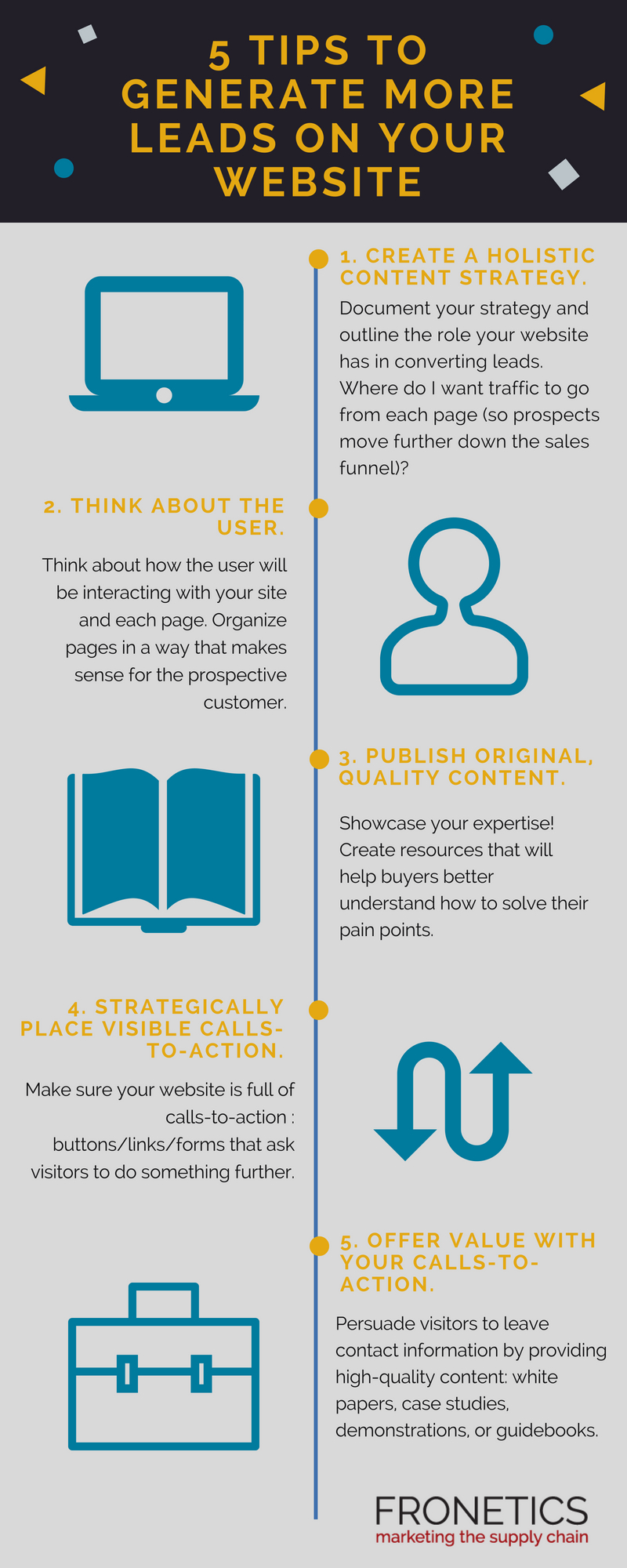
by Fronetics | Jun 26, 2018 | Blog, Content Marketing, Logistics, Marketing, Strategy, Supply Chain
More and more supply chain marketers are realizing the benefits of inbound marketing (over outbound marketing) including cost savings and increased lead generation.
Marketers are constantly coming up with new and trendy ways to attract leads. With endless platforms available to us, it can be overwhelming for even the most seasoned marketers to know where they need to focus their efforts.
In order to find the right solutions for your supply chain marketing needs, you first have to understand the difference between inbound and outbound marketing. And more importantly, how they can help — or hinder — your marketing efforts.
Outbound marketing
Outbound marketing describes any marketing approach that pushes a message onto a buyer. Traditional marketing — tv and radio ads, telemarketing, banner and display ads — are all examples of outbound marketing.
Another name for this marketing tactic is interruption marketing, as it typically tries to take “attention away from what your buyer is doing and bring it, forcibly, on to your product or service.”
Inbound marketing
Inbound marketing focuses on audiences finding you. Instead of pushing a message onto buyers, inbound marketing allows you to establish your brand as an industry leader and let interested audiences come to you. This type of marketing attempts to draw in potential customers through interesting and engaging content.
Content marketing is a type of inbound marketing. Examples include blog posts, social media, infographics, white papers, and videos.
Why is inbound marketing better for the supply chain?
Outbound marketing used to be the ‘go to’ for generating leads, but this is simply no longer the case. Marketers across industries have found that inbound marketing has many advantages over traditional marketing practices. In fact, almost three-quarters (68%) of inbound organizations believe their marketing strategy is effective, while more than half (52%) of outbound marketers don’t believe their strategy is effective.
[bctt tweet=”Marketers across industries have found that inbound marketing has many advantages over traditional marketing practices. In fact, almost three-quarters (68%) of inbound organizations believe their marketing strategy is effective.” username=”Fronetics”]
Here’s why we think inbound marketing is better for supply chain marketers than outbound marketing.
Video: Why supply chain marketers need inbound marketing
Related posts:


by Elizabeth Hines | Jun 25, 2018 | Blog, Content Marketing, Logistics, Marketing, Social Media, Strategy, Supply Chain
Aiming to deliver value outside the sales funnel allows your business to build long-term relationships with customers, rather than focusing on a single sale.
Congratulations! You closed the deal. You hammered out the terms and set up the billing. But, according to marketing experts Mark Bonchek and Vivek Bapat, now the real work of growing revenue begins.
Successful 21st century businesses focus on what happens after they close a sale, not the transaction itself. That’s because consumers — and B2B customers — have higher expectations than ever before. They read reviews, listen to webinars, and download white papers before they buy, and they expect a better experience after.
Purchase brands vs. usage brands
Bonchek and Bapat describe two types of brands: “purchase brands” and “usage brands.” The usage brands “focus on the moments of truth that happen after the transaction, whether in delivery, service, education or sharing.” As a result, they command greater loyalty and higher prices than competitive brands that are content to end their relationship with an invoice.
[bctt tweet=”Suppliers need to shift focus from persuading people to buy, to persuading them to become a committed advocate for their brand.” username=”Fronetics”]
What does that mean for you as a supplier? You need to shift your focus from persuading people to buy, to persuading them to become a committed advocate for your brand.
“Be” the B2B customer
B2B accounts are complicated. They have many decision makers and many points of contact. You may have a sales team with multiple reps and sales support people on one account.
With so much going on, it’s important to “be” the customer. Try to identify and understand the people who depend on your product or service to get their work done every day. Those are the people you need to impress.
“What is the likelihood that you would recommend Company X to a friend or colleague?” According to Bain & Company, this is the one question that most closely correlates to customer satisfaction. “High scores on this question correlated strongly with repurchases, referrals and other actions that contribute to a company’s growth.”
And what makes people recommend a product or service? Success while they’re using it.
Social media: An important part of the B2B relationship
Bonchek and Bapat say, “The purchase and usage mindsets are equally, or even more, relevant for B2B brands. Business solutions tend to have longer life cycles than consumer products and there is an even greater opportunity to deliver value outside the sales funnel.“
So yes, you may have to tweet. And stay present on LinkedIn. Because your customers look there to follow trends and find good information to help run their businesses. Industry forums, YouTube, and Instagram are also great places to provide value beyond the sale.
Don’t worry if you’re not a creative genius. Most of us aren’t. Do try to talk about issues that are relevant and maybe even unsettling to your industry. If your customers are having a problem, chances are other businesses have the same concerns and vice versa.
You probably have an opinion, maybe even a solution. Use social media to share it with a larger audience, your users will thank you for it.
How do you deliver value outside the sales funnel?
Related posts:


by Fronetics | Jun 21, 2018 | Blog, Content Marketing, Logistics, Marketing, Supply Chain
If you’re looking to generate more leads on your website, you need to create opportunities to capture visitors and implement a strong content strategy to encourage engagement.
Lots of supply chain and logistics companies are catching on to the benefits of content marketing. And of those, many are implementing a content marketing strategy to plan and execute their marketing.
[bctt tweet=”There’s no point in pouring a bunch of time, money, and resources into a robust content marketing program if the website that you’re driving traffic to stinks.” username=”Fronetics”]
But there’s an issue a lot of supply chain and logistics companies are running into: a weak website that doesn’t encourage the generation of leads. Essentially, there’s no point in pouring a bunch of time, money, and resources into a robust content marketing program if the website that you’re driving traffic to stinks.
In a recent post, we talk about what a weak website looks like. If you think you may fall into this category, don’t fret. There is still time to generate more leads on your website.
Consistently producing quality content and making sure you’re utilizing various distribution channels — social media, a blog, etc. — will help draw your target audience to your website. Once they’re on your site, you need to make sure they have a positive user experience. And more importantly, they need ample opportunities to learn more about your products and services.
These opportunities to engage with your content help move users down the sales funnel. You’ll capture leads that have the potential to become sales.
So how do you ensure your website is a lead-generating machine? Here are five tips to generate more leads on your website.
Infographic: 5 tips to generate more leads on your website

(Made with Canva)
Most importantly, remember to be prudent about the role your website plays in the lead-generation process. A strong website with quality content, great visuals, and easily identifiable calls-to-action only works to generate leads and push users down the sales funnel. You’ll still need someone to help close the deal.
Related posts:


by Elizabeth Hines | Jun 20, 2018 | Blog, Current Events, Leadership, Logistics, Strategy, Supply Chain
Artificial intelligence is forcing change on the supply chain in many ways. But robots, autonomous vehicles, and drones are just part of the equation. Does AI pose a threat to supply chain leadership as well?
A recent Harvard Business Review article explores the idea that “in an AI age characterized by intense disruption and rapid, ambiguous change, we need to rethink the essence of effective leadership. Certain qualities — such as deep domain expertise, decisiveness, authority, and short-term task focus — are losing their cachet, while others, such as humility, adaptability, vision, and constant engagement, are likely to play a key role in more-agile types of leadership.”
Can AI change supply chain leadership as we know it?
What is AI and why does it matter?
Artificial intelligence is coming to your business whether you’re ready for it or not (if it hasn’t already). Why does it matter? Because AI — the ability of machines to carry out tasks in a way we consider “smart” — can boost productivity and profitability.
What AI does “extraordinarily well,” according to consulting firm McKinsey & Co., “is relentlessly chew through any amount of data and every combination of variables.”
[bctt tweet=”Today we’re experiencing a second machine age as computers take on some of our mental workload by making data-driven decisions.” username=”Fronetics”]
Some technologists draw parallels to the Industrial Revolution when machines lightened the load for humans by performing tasks that once required brute strength. Today we’re experiencing a second machine age as computers take on some of our mental workload by making data-driven decisions.
The glass-half-empty crowd is worried that machines will replace humans and take our jobs. But the glass-half-full team sees new opportunities to unburden ourselves from repetitive tasks so we can focus on bigger strategic issues that need the nuanced emotional intelligence only we humans possess.
Traditional vs. AI-ready skills
“At some point in our evolution… leadership acumen transitioned from physical to cognitive skills, putting a premium on intelligence and expertise at the expense of force and strength,” writes HBR article authors Tomas Chamorro-Premuzic, Michael Wade, and Jennifer Jordan.
Offloading repetitive cognitive tasks to machines frees up time to develop new leadership skills. According to the authors, tomorrow’s leaders will be more empathetic, more agile, and more connected to people around them. The authors describe four specific qualities that will define leaders of the future:
Humility
Valuable intelligence won’t be delivered from the top down and may not come from the most experienced people on the team. It will come from every direction. Leaders should be open to suggestions and input from people using data at every level inside and outside the organization.
Adaptability
Changing your mind is a good thing in the age of AI. Learning organizations should expect to revise plans and iterate quickly. Managers should be confident enough to propose a change of course based on new data and not feel the need to defend their decision.
Vision
Operations can feel like shifting sands in an AI environment. An organization that continuously adapts to capitalize on new opportunities can leave employees feeling like they don’t know what they’re supposed to be doing from one day (or minute) to the next. Successful leaders will emphasize long-term goals, encourage questions, and provide clear, thoughtful, consistent answers.
Engagement
Successful leaders will come out of their executive suites and connect with customers, partners, and employees. You can’t wait for reports and meetings when fast-paced data-driven decisions are happening all around you. “Agile leaders need to stay engaged… and find ways to keep their teams engaged, particularly when the going gets rough and the path gets challenging,” according to Chamorro-Premuzic, Wade, and Jordan.
So will AI change supply chain leadership?
Learning and applying new skills won’t come easily for many businesses. Some managers might not be comfortable asking employees to demonstrate humility, adaptability, and vision. These are hard skills to measure and haven’t always been rewarded.
Real digital leadership will require a blend of human and machine learning and a new way of understanding how things get done. Any company stands to gain by adopting these new ideas.
Logistics companies, at the nexus of operations for so many industries, can lead the way into the AI age by modeling new skills and applying them to their own businesses.
Machine-learning expert Jeremy Howard sums it up nicely in a McKinsey & Company report: “There is no organization that shouldn’t be thinking about leveraging these approaches, because either you do — in which case you’ll probably surpass the competition — or somebody else will.”
What ways do you think AI will change supply chain leadership?
Related posts:


by Elizabeth Hines | Jun 19, 2018 | Blog, Content Marketing, Current Events, Logistics, Manufacturing & Distribution, Marketing, Supply Chain
Tesla has been long-favored to lead the charge in the mass adoption of EVs, but recent challenges have halted production. Can the Tesla become the next Honda Accord before they run out of money?
Plug-in electric passenger cars achieved a market share of only 1.16% of all car sales in 2017. That’s tiny. Some predicted 2018 might be the “year of the electric car,” but sales aren’t expected to break 2% this year.
[bctt tweet=”The auto industry is betting billions that electric vehicles will soon be as “cheap and ubiquitous as conventional cars.”” username=”Fronetics”]
Nearly all experts believe, however, that change is indeed coming. The auto industry is betting billions that electric vehicles (EVs) will soon be as “cheap and ubiquitous as conventional cars.” Some projections put electric vehicle sales over 20% by 2025. Others are more cautious and predict a slightly delayed rise to 25% by 2030. If the industry hits those numbers, it will be a boon to the electronics industry, as the number of cars with electronic components and the number of electronic components in each car grows by leaps and bounds.
Tesla has been long-favored to lead the charge in the mass adoption of EVs. But production of the company’s Model 3, the carmaker’s attempt at a mass-market sedan, has had major challenges, including issues with its supply chain. Can Tesla beat the ticking clock before the massive influx of money dries up?
Tesla’s ticking clock
Tesla is racing to overcome obstacles that have slowed the Model 3 progress, and the company’s make-or-break moment is fast approaching. The carmaker must boost production of the Model 3, or they will run out of money by the end of the year.
Since going public in 2010, Tesla has burned through an estimated $10 billion. Last year alone, Tesla spent more than $3.4 billion in cash — almost $1 billion a quarter — largely to bring production and sales of the Model 3 to sustainable levels.
Earlier this month, Tesla revealed that it nearly hit its target to manufacture 5,000 Model 3s a week, a production goal that is necessary to generating enough cash in house to sustain its own operations. Without it, the automaker will need to raise even more capital from outside investors.
Everyone expects that Tesla could, in fact, raise more funds if necessary. But proving it can build Model 3s at the thrice-promised target rate would go a long way in securing it.
The issues working against EVs
Even without its production issues, Tesla and other electric-vehicle manufacturers have their fair share of roadblocks.
The biggest issue to the supply chain? Electric-car battery manufacturing depends on the supply of certain minerals, including cobalt and lithium. As demand increases, these raw materials are increasingly scarce. Manufacturing is literally running into a metal crunch.
The biggest logistical issue? There are currently not enough places to re-charge.
Where exactly will we charge all those electric cars we plan on buying? Experts say that simply duplicating the existing refueling system, where motorists “charge up” like they “gas up” today would likely require dozens of new power plants or massive new investments in solar and wind farms.
The biggest issue to the American consumer? Battery-powered cars still cost more. Until that changes, consumers will still have a reason — a big reason — to go for more traditional gas-powered vehicles.
Could the Model 3 become the next Honda Accord?
So, even with all these current issues, could the Model 3 still be the highest-selling car of the next 40 years?
Tesla may still have a fighting chance if:
- they can solve their production issues;
- the battery market can find alternatives to its raw-materials shortage;
- the American public can feel confident that their batteries won’t die on the highway;
- the cost of EVs can rival that of traditional vehicles
Admittedly, that is a lot of “ifs,” but somehow no one is REALLY doubting that Tesla will pull it all off. But, not yet. A study last year found that 70% of millennials don’t yet want an electric car. Huh. Electric cars have mystique but simply don’t yet have widespread appeal.
Even taking these surprising stats into consideration, that still means 30% of young buyers consider an electric vehicle even now. So, by 2025 or 2030, when all the kinks are ironed out, they just may be as vanilla as Honda Accords. Except that the Model 3 is gorgeous, and electric, and made by Tesla. So maybe more like vanilla with rainbow sprinkles.
This post originally appeared on EBN Online.
Related posts:


by Fronetics | Jun 18, 2018 | Blog, Content Marketing, Logistics, Marketing, Strategy, Supply Chain
Looking for blog post ideas? Try using these resources to create topics that are original, relevant, trendy, and — most of all — relevant to your business.
I’ve said it once — ok, way more than once — but I’ll say it again: The more you blog, the more leads you’ll get.
That’s all very well and good, but what happens when you have no idea what to write about?
As usual, the internet is coming to your rescue. Here are four of our favorite online tools to help you generate blog topic ideas.
4 online tools to generate blog post ideas
1) HubSpot’s Blog Ideas Generator
Remember Mad Libs? Give HubSpot three nouns, and its Blog Ideas Generator will give you blog ideas.
While not exactly a Mad Lib, this tool is a great way to focus on topics where you want to cultivate your authority. It’s an excellent way to generate blog post ideas for a topic cluster, in line with existing pillar content.
2) Alltop
Co-created by legendary business advisor and author Guy Kawasaki, Alltop describes its goal as helping you to answer the question “what’s happening” in topics that pertain to your business.
Essentially, it’s a list of recent posts from the most trusted blogs on each topic. Select your topic, and you’ll get posts relating to that topic from the top blog in each industry. It’s gives you a great “in” on the most important conversations going on among thought leaders in the supply chain — and your goal is to become one of them.
3) Ubersuggest
It may not be the best tool for coming up with actual post titles, but Ubersuggest is a great way to generate general topic ideas for new posts. Enter a word or phrase, and Ubersuggest produces a long list of results containing the word or phrase followed by related phrases.
4) Twitter
[bctt tweet=”Yes, you read that right. Twitter can actually be a great way to generate blog post ideas.” username=”Fronetics”]
Try running a Twitter search using your keyword proceeded by a hashtag (#procurement, for example) to get a list of tweets containing your keyword. Twitter also has the bonus of being likely the most up-to-date conversation you can find on the web.
Do you use any tools to generate blog post ideas?
Related posts:













